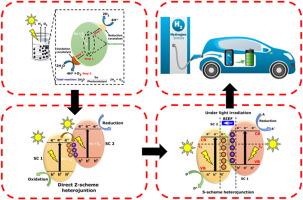用于光催化水裂解的z型和s型异质结构光催化剂:高效产氢研究进展
IF 7.9
3区 材料科学
Q1 GREEN & SUSTAINABLE SCIENCE & TECHNOLOGY
引用次数: 0
摘要
温室气体排放导致的全球变暖加上化石燃料的有限供应是人类面临的首要问题。分解水得到氢是替代化石燃料和减少温室气体排放的最具创新性的替代方案之一。光催化水分解反应取决于半导体光催化剂吸收太阳光中的光子并产生e -和h+对的性能和效率。在开发可用于高效分解水的新型光催化剂的过程中遇到的主要挑战之一是“e -和h+对的重组”,通常称为载流子重组。在所有通过异质结形成来解决这一挑战的替代方案中,Z -方案和S -方案异质结方法显示出最有希望的结果。本文综述了Z -型和S -型异质结光催化剂的最新研究进展。此外,本文还讨论和评价了牺牲剂、缺陷工程、掺杂效应以及内建电场(BIEF)对光催化水分解的影响。本文认为,提高光催化剂的效率和稳定性是理解Z -方案和S -方案异质结中电荷转移机理以及在光催化水分解方面取得进一步进展的必要条件。本文章由计算机程序翻译,如有差异,请以英文原文为准。

Z-scheme and S-scheme heterostructured photocatalyst for photocatalytic water splitting: A review towards efficient H2 generation
Global warming due to greenhouse gas emissions couple with the limited supply of fossil fuels are in the fore front of the problems facing humanity. Splitting H2O to get hydrogen is among the most innovative alternative to replace fossil fuels and reduce greenhouse gas emission. Photocatalytic water splitting reaction depends on the performance and efficiency of semiconductor photocatalysts to absorb photons from sunlight and generates and pairs. One of the main challenges experienced in development of novel photocatalysts that could be used to efficient split water is “recombination of and pairs”, often called charge carrier recombination. Of all the alternatives to resolve this challenge via heterojunction formation, the Z scheme and S scheme heterojunctions approach shows the highest promising results. This review attempts to overhaul the latest achievements made in development of Z scheme and S scheme heterojunction photocatalysts. Additionally, the review discussed and evaluate the role of sacrificial agent, defect engineering, doping effect, along with effect of built in electric field (BIEF) as strategies to enhance photocatalytic water splitting. The review concludes that increasing the efficiency and stability of photocatalysts is necessary to comprehend the mechanism of charge transfer in Z scheme together with S scheme heterojunctions as well as obtaining further progress in photocatalytic water splitting.
求助全文
通过发布文献求助,成功后即可免费获取论文全文。
去求助
来源期刊

Materials Today Sustainability
Multiple-
CiteScore
5.80
自引率
6.40%
发文量
174
审稿时长
32 days
期刊介绍:
Materials Today Sustainability is a multi-disciplinary journal covering all aspects of sustainability through materials science.
With a rapidly increasing population with growing demands, materials science has emerged as a critical discipline toward protecting of the environment and ensuring the long term survival of future generations.
 求助内容:
求助内容: 应助结果提醒方式:
应助结果提醒方式:


